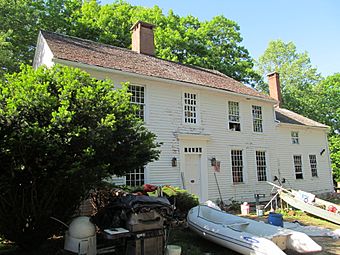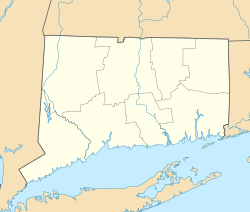Applewood Farm facts for kids
Quick facts for kids |
|
|
Applewood Farm
|
|

Farmhouse at Applewood Farm in 2014
|
|
| Location | 528 Colonel Ledyard Hwy., Ledyard, Connecticut |
|---|---|
| Area | 3.6 acres (1.5 ha) |
| Built | 1826 |
| Architect | Gallup, Russel |
| NRHP reference No. | 87001765 |
| Added to NRHP | October 15, 1987 |
Applewood Farm is a historic farm located in Ledyard, Connecticut, USA. Russel Gallup built the main farmhouse in 1826. It has a classic colonial design with a large chimney in the middle. The house also has some fancy Federal style details.
The farm got its name from the apple orchards Russel Gallup planted. Over the years, the farm grew and changed. It was owned by the Gallup family for a long time. Later, it became a popular bed and breakfast, where visitors could stay overnight.
In 1987, Applewood Farm was added to the National Register of Historic Places. This means it's an important historical site. The property includes several old buildings, like the farmhouse, a corn crib, a barn, a silo, and a chicken coop. There's also a newer shed for machinery.
Contents
Discovering Applewood Farm's Past
Applewood Farm has a long and interesting history. It was built by Russel Gallup in 1826. This was even before Ledyard became an official town in 1836!
The Gallup Family's Legacy
Russel Gallup was not just a farmer. He was also a soldier in the War of 1812. For over 50 years, he was a deacon at the Ledyard Congregation Church.
Russel passed down parts of the farm to his son, Rufus Gallup, in 1855. When Russel died in 1869, Rufus took full ownership. Rufus then did the same for his son, Russell Gallup II, in 1877.
Russell Gallup II was a teacher. He also served as a Judge of Probate from 1896 until he died in 1911.
Everett Gallup took over the farm in the 1920s. He was the last Gallup family member to own this historic property.
From Farm to Bed and Breakfast
After the Gallup family, Arlene Meyer Cohen owned the farm. In 1984, a large part of the original land (about 40 acres) was sold.
Later, the Betz family bought the farmhouse. They wanted to turn it into a bed and breakfast. This is a place where people can pay to stay overnight and get breakfast.
In 1987, when the Betz family owned it, Applewood Farm was officially added to the National Register of Historic Places. It was known as "Applewood Farms Inn" and had six guest rooms. It operated as a bed and breakfast throughout the 1990s.
How Applewood Farm Was Built
The main farmhouse at Applewood Farm was built around 1826 by Russel Gallup. It's a two-and-a-half-story building. Its design looks like older colonial houses with a central chimney. It also has fancy details from the Federal style.
The Farmhouse Design
The farmhouse is about 36 feet (11 meters) long and 28 feet (8.5 meters) wide. Around 1842, a smaller wing was added to the east side. This wing is about 20 feet (6 meters) by 16 feet (5 meters).
A back section, called a rear ell, connects to a long shed. The house and all its additions have pointed roofs. In 1987, these roofs were covered with wooden shingles.
The farmhouse has six fireplaces. The ones downstairs are made of large granite blocks. The upstairs fireplaces are made of brick.
Over the years, the house has been updated. The kitchen and bathrooms were modernized. But these changes didn't really alter the original layout of the house. Some updates, like a new door in 1986, were made to meet important fire code safety rules.
Other Farm Buildings
Besides the main house, several other buildings are important to the farm's history:
- A corn crib: This building, about 12 feet (3.6 meters) by 15 feet (4.5 meters), was rebuilt and dates back to the 1800s.
- The barn: This large building is about 32 feet (9.7 meters) long and 20 feet (6 meters) wide. It has big double doors on both the east and west sides.
- A dairy shed: This was added to the barn in the early 1900s. It's about 43 feet (13 meters) long and 20 feet (6 meters) wide.
- A silo: This tall, round structure is about 31 feet (9.4 meters) around.
- A chicken coop: This building is about 20 feet (6 meters) by 45 feet (13.7 meters).
Both the silo and chicken coop were likely built in the early 1900s. There's also a machinery shed from the 1960s, but it's considered a newer addition and not part of the original historic farm structures. In 1987, the historic part of the farm was about 3.6 acres. The original farm was much larger, about 144 acres.
Why Applewood Farm is Important
Applewood Farm was a working farm for over 100 years. In 1850, a survey showed it produced many things, including:
- Butter and cheese
- Rye and Indian corn
- Oats and wool
- Irish potatoes and hay
The three apple orchards planted by Russel Gallup were very important. They even gave Applewood Farm its name!
When Everett Gallup took over in the 1920s, the farm produced fresh fruits, vegetables, poultry, eggs, and dairy products. In 1994, Applewood Farm was known for its maple syrup production. They had 700 trees tapped for syrup and showed visitors how it was made.
Applewood Farm was added to the National Register of Historic Places in 1987 for two main reasons:
- History: The Gallup family played a big part in the local history of Ledyard.
- Architecture: The farmhouse is a great example of a late colonial house with a central chimney.



